The other day, we looked at this fantastic piece of goldwork embroidery by Cristina Badillo. When Cristina sent the piece off to Larissa, who commissioned it, she sent along some samples of the various gold threads in the piece.
Larissa, understanding my inordinate infatuation with goldwork threads, generously shared some cuttings with me, and today, I want to share them with you, virtually.
I like to examine embroidery threads from different countries, especially goldwork threads. Here in the States, most of our goldwork threads come from England and Japan, but there are other goldwork thread manufacturers in other parts of the world, too; looking at these threads may give us a broader perspective on goldwork and may also help those who are interested come up with resources in their own countries or in other countries.
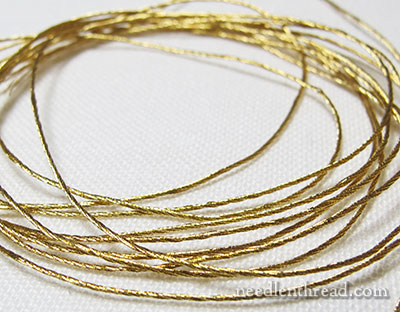
This is one of the threads that caught my attention right away. This thread is labeled “Torzal No. 6.” It’s the outlining the leaves and making the tendrils, that I pointed out in Tuesday’s article on goldwork.
To my knowledge, we don’t have a thread like this available in the States. It is a six-ply thread, made up of tiny plies of metal thread similar to passing thread. The six plies are lightly twisted together to make a very smooth, shiny bunch of threads.
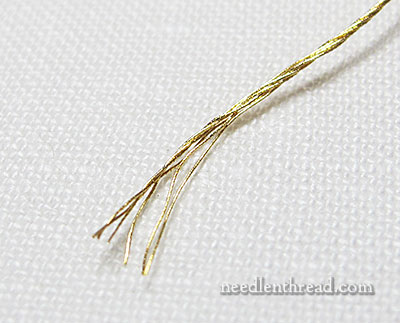
You can see here a better detail of the thread, with the six plies separated at the end. Notice that the twist is not rope-like, but rather very gently twisted, so that the thread almost looks like liquid gold – it really gleams! Larissa, who sent the thread samples, explained that there is also a 20-ply thread just like this available in Spain.
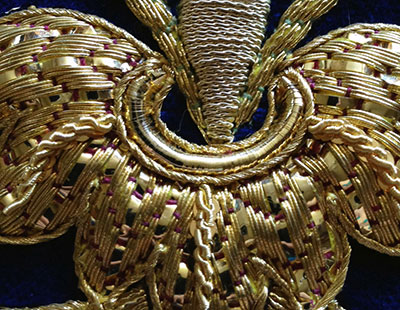
You can see the 20-ply Torzal in the photo above, outlining the broad plate ring in the center of the photo.
This thread fascinates me! It looks like a wonderful thread for adding either delicate (the six-ply) or heavy (the twenty-ply) smooth gold outlines.
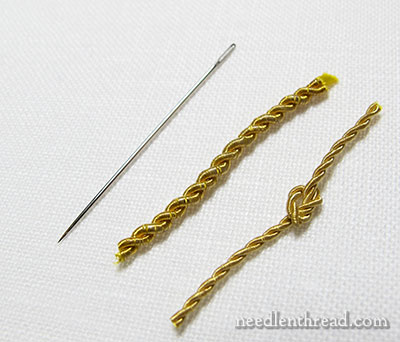
These threads have the look of twisted purl, or purl s-ing. They are very much like Gimp cord available here, but the wire around the core threads is much finer, and the whole cord is a two-ply cord, rather than a three-ply cord.
I put a #9 crewel needle in the photo there, so that you could get an idea of the thickness of the cords.
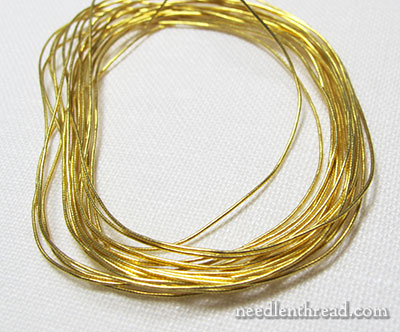
This is a smooth passing thread, very much like the smooth passing threads we have available, only it is somewhat more flexible – it has the feel of goldwork tambour thread, but it is thicker – slightly thicker than a #5 smooth passing thread.
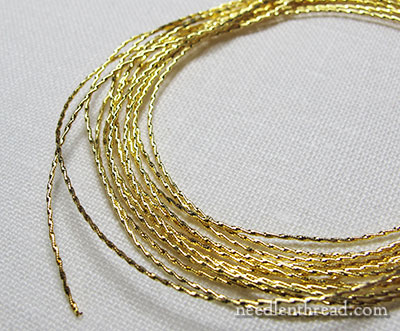
And now, we get to this. And this is where I fell in love.
It looks like check thread, but it’s not the same check thread that I’ve been using. Rococco, maybe? No, it’s too fine to be rococco. This is a very fine check thread – at least, it has the characteristics of check thread – but it is much more defined than the finer check threads I’ve used.
Also, it’s a little different in structure.
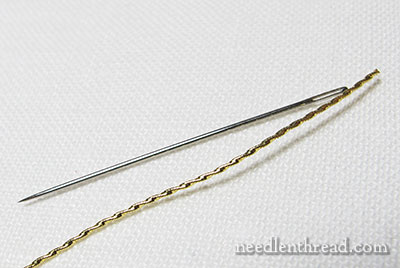
Here’s the thread, lined up with a #9 crewel needle, so you can see the size.
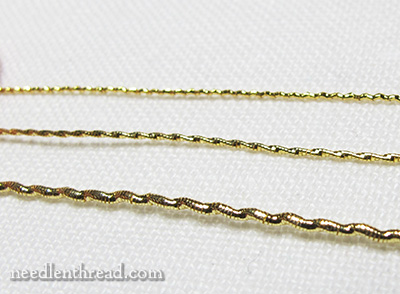
Here, you can see three similar threads lined up next to each other. The top thread is check thread #7. It is relatively fine and wavy, but the waviness is not precise or “smooth” – it looks a little rough.
The middle thread is the Spanish thread we’re discussing.
And the thread at the base of the photo is rococco, size “fine” (it doesn’t look too fine next to the others!).
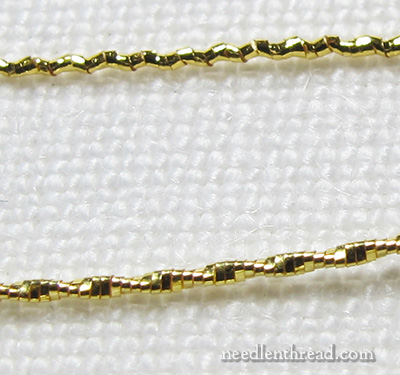
Here, you can see a close up of the check thread #7 at the top of the photo, and the Spanish thread in question. When I look at the Spanish thread close up, it reminds me somewhat of flatworm, only it’s somewhat thicker in relation to its width, and it is evenly twisted or crimped.
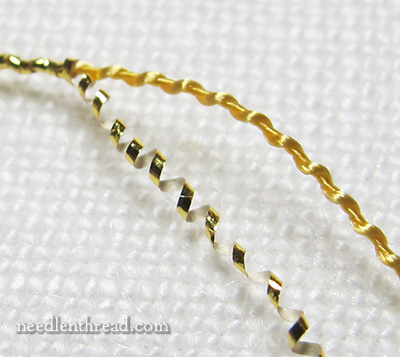
And now, let’s take them apart. This is the check thread #7 that I’ve been using on the Mission Rose project, and that I also used on the Marian Medallion project. The core (the yellow thread there) looks like it is made of a straight cord that has another cord twisted around it. This twist around the straight cord is what gives this particular check thread its wavy peaks and valleys.
The gold wrapped around the core is not wire. It is more like the paper / foil-like gold found on Japanese thread.
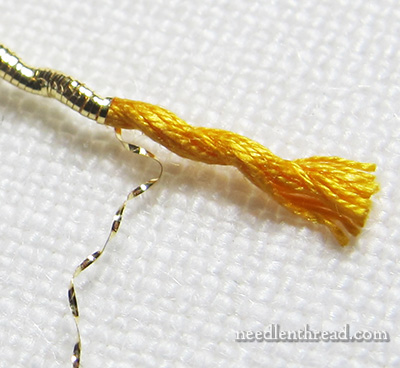
This is the rococco, coming undone. Notice that the core is made of a thick bunch of many strands of twisted threads, and the strands are all twisted together, and then the flat gold wire is wrapped around the thread. This thick twisted cord makes rococco a less flexible thread.
The gold is wire-like, not paper-like.
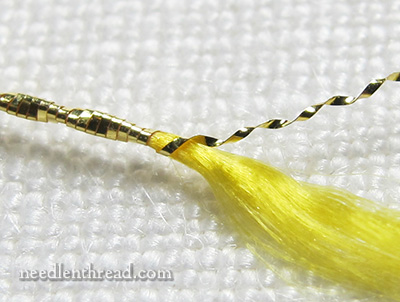
And here’s the Spanish sample. The core is made up of very fine flat (no twist) threads. The whole bunch of threads (it reminds me of fine flat silk, but I think it’s polyester – I didn’t have a chance to test it to see, but I will later on) is pretty much untwisted. If there is a twist, it’s a very light twist that just follows the twisty crimp in the thread, and when the core is unwrapped, any twist that might be there falls right out flat.
The gold is flat and wire-like, like the gold on the rococco. This thread is much more flexible than the rococco; it pinches well and takes tight, sharp corners.
Again, it’s not like the check thread I’m currently using (maybe there’s another type of check thread available that I haven’t tried – I’ll pursue that), and it’s not like rococco. I’m going to explore further to see if there is an English goldwork thread counterpart. If there is, I haven’t seen it, but I haven’t seen every type of goldwork thread, either.
So there they are – Spanish goldwork threads. I’d love to know who the manufacturer is and if the threads are available outside Spain. Or maybe I just need a really good excuse to take a European vacation?
Ah, me. I’m a sucker for goldwork threads!







Lush threads! Esp love the plaited/twisted ones.=)
I hate rococco thread. Every time I see it for sale, there’s already some of the base yellow thread showing, and that’s before it’s even been used. I’d love to use some, but some that looks good and, preferably, will stay that way!
Thread buying in Spain. What a hardship!!=)
Thank you for another fascinating article. I haven’t thought of using goldwork thread, but all this information about it is very interesting and may tempt me to try. I always learn something from what you write. Thanks again.
Thank you for showing us these threads, Mary. It was interesting to see the similarities and the differences between those and the threads available to us in the UK/USA.
I will be travelling to Madrid in a couple of weeks for a long weekend. I have been trying, so far in vain, to locate some embroidery/bead shops to visit while there. If any of your readers are aware on any sources for embroidery supplies, beads or gold threads in Madrid, I would dearly like to hear about them.
I am an enabler. This is the internet age. Although a trip to Spain is a wonderful idea, you can probably find a website where you can buy the thread.
A great post I really enjoyed reading. Please keep us up to date as to sources and other threads you find!
Dear Mary
It’s interesting the amount of different gold thread there is. I would be interested to see the Torzal with the 6 ply as it looks an interesting gold thread. I really like using Gimp gold and would like to compare the look a like Spanish Gimp gold. Again check threads is one of my favourite gold thread and I would be interested in comparing this with the Spanish gold.
I like the Spanish rococo gold with the silk like core. Like you I would be interested in obtaining some of these gold threads and would like to know the manufacturer. Thanks for sharing this with us Mary very interesting.
Regards Anita Simmance
Interesting. I was going to ask who made these. Maybe we should ask Cristina. Meanwhile I’ll search in Spanish. I really like those. Their plate looks a little different, too.
This is a manufacturer catalog Mary, don’t think is possible to find the threads outside Spain but maybe they can ship worldwide:
http://www.hijosdeemiliogomez.com/pdfs/HilosThread.pdf
http://www.hijosdeemiliogomez.com/
Hope that helps,
Francesca
How very interesting, Mary. You are a great researcher!! I appreciate the education.
Hi Mary,
Would you please share the source of the manufacturer with us? I would love to know where to buy these threads. I recently learned of a manufacturer in Austria: http://www.mmaurer.at/dt/company/index.htm. Haven’t had a chance to test them yet.
Have a nice day, Jessica
What a splendid analysis and education in these threads, Mary! I am so glad to understand their structure. Thank you very much.
Arrrgh! This stuff is GOURGEOUS – So, I tried googling ‘Spanish Goldwork Threads’ and the only promising site was one that my anti-virus program kicked me back from…there’s got to be a way – but it’s too late tonight (or waaaay too early this morning) for me to find it now. Thanks for introducing us to this beautiful thread…
Mary ,This is so interesting and now I want to know more. What would be the best book for beginners on goldwork …even though I do generally tend to jump in at the deep end !?
Mary,
One source seems to be “Fabrica de tirador de oro”, see catalog at http://www.hijosdeemiliogomez.com/home.html
If you click on “hilos” it will provide a 2.55 MB .pdf of various metal threads. The vendor is in spain. Note the catalog is in spanish.
Cheers,
Kimberly
I found them, too. I’ll have to use the laptop, but I read Spanish, so I’ll email and ask them if they ship international.
I found this by googling on Spanish google (google.es) in Spanish (search term “hilos de oro para bordar” — gold threads for embroidery). If you speak Spanish, these links are great!
https://www.facebook.com/HilosDeOroFinoYEntrefinoParaBordadosCofrades
It is the FB page for sellers of threads for the type of work that Cristina does (for religious cofradias — brotherhoods or guilds — that venerate a particular saint and take the image out on specific holidays).
Video of Spanish embroiderers —
https://www.youtube.com/watch?v=pw6ioBxzEJM
Another website to buy from:
https://www.el-angel.com/cofradias-cordones-hilos-bordar-oro-plata-oro-fino-plata-fina-3506-fp.asp
The above are in Madrid at Calle Esparteros NO. 3. Maybe I’ll go there when I go in November!
Cool blog by a restorer with lovely pictures:
http://bordadooro.blogspot.com/
All the goldwork embroidery terms in Spanish…
http://pakilibenitez.blogspot.com/2010/02/el-bordado-tecnicas-y-material.html
It seems like there is quite an industry supporting the cofradias… There are quite a few places where you can buy goldwork to apply to outfits or whatever, and a good number of places that will do bespoke goldwork embroidery.
Thanks! It would never have occurred to me to look into this. I’ve learned a lot from this. Thanks!
http://www.hijosdeemiliogomez.com/
I emailed them and they will ship. I’m going to order something but have to figure out which ones. I don’t know if they speak English, but I’ll ask.
Oh, yeah, does anyone know what they call the little bastion intros they wind the thread around are called? I’m going to have to find that.
Darn autocorrect. That was bastoncito, the spindle thing with the thread wound around.
It’s called a broca.
Another source for high quality Spanish gold threads and trims is Monforte Systemfil:
http://www.monfortesystemfil.com/index.html
They are looking for a US distributor.
Maybe what the French call clincon .
“I’m a sucker for goldwork threads!”
Aaaaaand, now I am too! I have a feeling this could be an expensive hobby. Hahaha